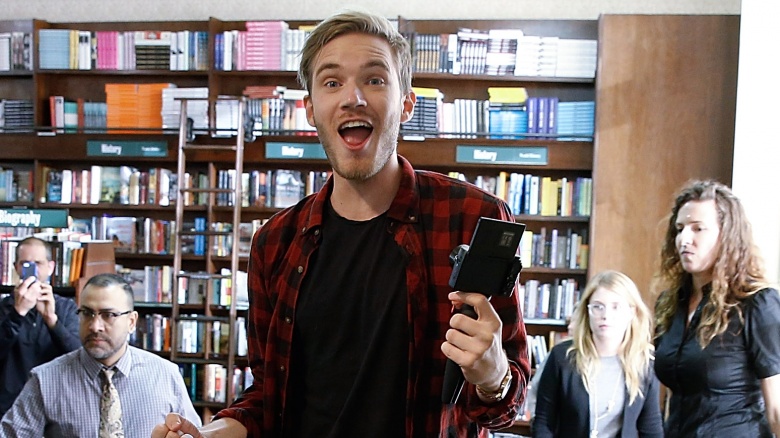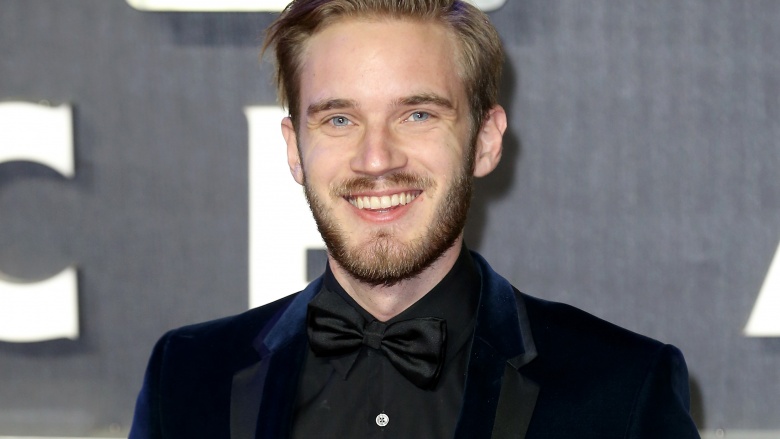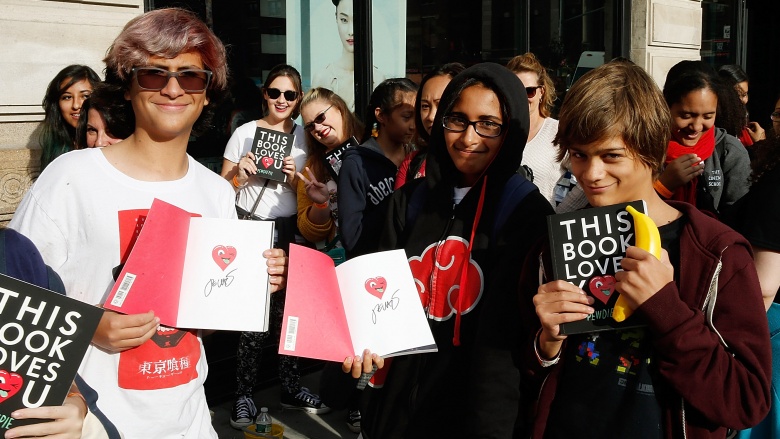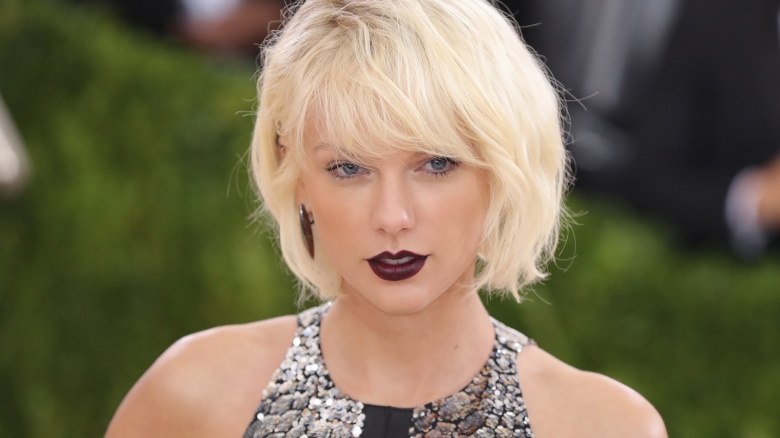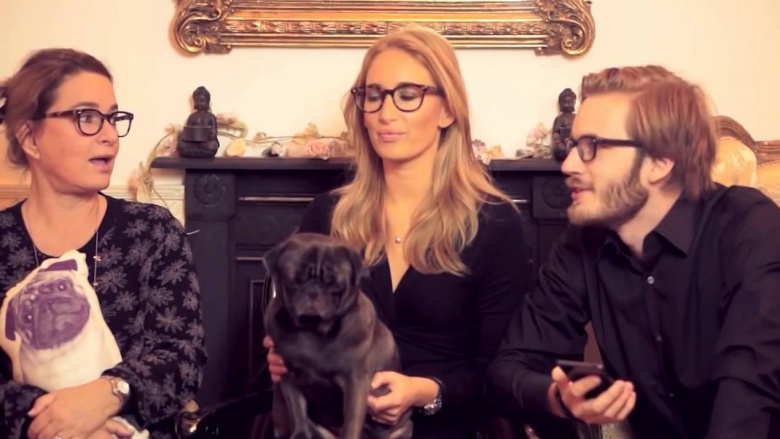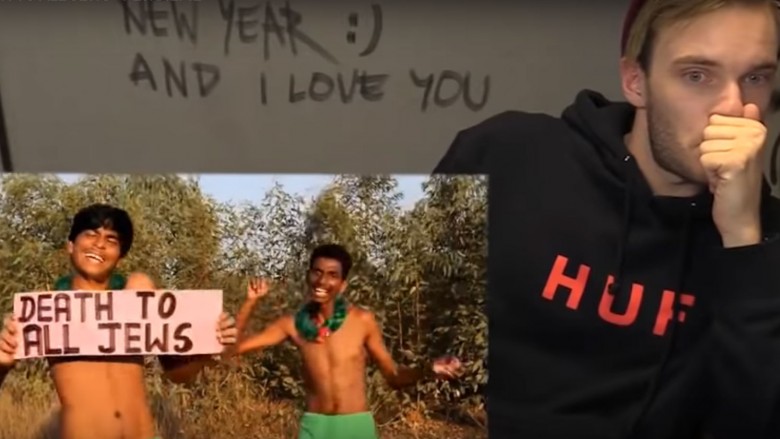Facts You May Not Know About PewDiePie
When PewDiePie visited The Late Show, Stephen Colbert said, "I want to thank the internet for allowing their emperor to be here this evening." It was obviously an exaggeration for comedic effect, but if we had to elect an internet leader, PewDiePie—a.k.a. Felix Arvid Ulf Kjellberg—would certainly be in the running. The 26-year-old Swedish native claims more than 47 million followers on his YouTube channel (the next closest channel has 28 million), making him basically the LeBron James, Katie Ledecky, and Tom Brady of YouTube. While even your grandparents have probably heard the name PewDiePie, how many people really know his story? Here are the gritty details behind YouTube's happiest superstar.
Forgot his original YouTube channel login
One of the first questions people inevitably ask after learning about PewDiePie is what the hell his name means. Turns out, it doesn't really mean anything. The first part "Pew" is the sound a laser makes, or as Colbert put it, "That's the sound of someone who can't make a laser sound." "Die" is, ya know, die. PewDie is what Kjellberg named his first YouTube channel, which he launched in December of 2006. Somewhere along the way, however, he forgot the login information, and he needed to start another one in 2010. Instead of PewDie2, he added "Pie," because the man really loves pie.
Someone at YouTube must have helped Kjellberg recover his original login information, because the oldest video uploaded to PewDie is from 2012—well after he started the PewDiePie channel—and he refers to himself in the vido as "PewDiePie." The original channel has more than 440,000 subscribers and 14 videos, with the most recent (about spammers trying to impersonate PewDiePie in YouTube comments) uploaded on May 25, 2013.
Financial analysts say PewDiePie is underpaid
$7.4 million seems like a lot of money to a college dropout. Hell, $7.4 million seems like a ton of money for 99% of the world. But according to some analysts, it's nowhere near what Kjellberg should be earning per year. Let's get into some math now (we swear it's interesting, so don't glaze over like you would in algebra class).
Michael Thomason of Forbes wrote, "Ad analytics firm Emarketer estimated YouTube would earn $5.6 billion from ad revenue in 2013, about two-thirds of the $8.5 billion CBS earned from ad revenue for its network television business." CBS's highest-rated show during that year was The Big Bang Theory, with an average of 18.7 million viewers per week. That's less than half of PewDiePie's subscriber base. Experts estimate that CBS roughly earned $6.5 million per week on advertising revenue from that sitcom alone, which means in one week, CBS earned nearly as much as Kjellberg did in one year. Popular YouTube creators seem like they earn a lot of money for just goofing around on camera, but it's only an extremely small percentage of what YouTube makes.
The Bro Army is one of the most controversial online fan bases
The term "bro" has all kinds of negative meathead connotations in the United States. Since Kjellberg is Swedish, we're not sure about his awareness of these stereotypes, but he started calling his fans "bros" and they ran with it: they give each other the "Bro Fist" as a greeting and call themselves "The Bro Army." It started as good fun, but many of them have started living up to the negative connotations of the term. Many of the most popular Let's Play gamers will play the same games in videos. However, if any of them play a game that PewDiePie already has, the Bro Army comes after them in force for "copying." Obviously, online comments are known for being especially harsh, but PewDiePie's fans can get murderous. Popular YouTubers like Tobuscus and UberHaxorNova have felt the wrath. PewDiePie himself responded by posting a video mocking his own fans and disabling comments on his own uploads for a while, saying it made him happier.
PewDiePie is a serious philanthropist
As harsh at the Bros can be and as much flack as PewDiePie has gotten for making millions, he and his fans have done a lot of good. Kjellberg and the Bro Army have already raised over $630,000 for Save the Children, $446,512 for Charity: Water, and tens of thousands for additional charities, including the World Wildlife Fund and St. Jude Children's Research Hospital. He made a video two years ago announcing they'd raised over $1 million for charity, and the number is no doubt now much higher. Kjellberg hasn't publicized his charity work much, perhaps because he's reluctant to discuss money after all the backlash from his personal earnings over the last two years.
Relentlessly begged Taylor Swift to follow him on Twitter for years
PewDiePie started tweeting Taylor Swift in 2013, begging her to notice him and referring to her as "senpai," which is a Japanese term for a mentor and popular anime character trope. He continued his tweet campaign throughout 2014, also making videos and Photoshop designs dedicated to her. At the beginning of 2015, it appeared as if he might be ready to give up, threatening to become an Ellie Goulding fan instead if Swift didn't notice him. Finally, toward the end of January 2015, Taylor Swift's Twitter finally followed PewDiePie. It happened after he'd tweeted two photos of them, side-by-side, comparing their similar fashion styles.
Later in 2015, someone hacked @taylorswift and released some of her DMs, one of which was between the two. It wasn't racy, however—just your average introductory banter.
PewDiePie and CutiePieMarzia met after she sent him a fan letter
In 2011, Italian native Marzia Bisognin, now known online as CutiePieMarzia, became familiar with Kjellberg's work when some friends told her to go online to watch "this idiot playing video games." She became taken by "this idiot" and wrote him a fan email. It didn't take long for PewDiePie to respond and then fly out to Italy for an IRL date. Only a year later, Bisognin moved to Sweden and started a YouTube channel of her own. The two bounced back to Italy for awhile before settling in Brighton, England with their two pugs, Edgar and Maya.
Supported himself by selling hot dogs
Before he caught the YouTube bug, Kjellberg went to Chalmers University of Technology for a degree in industrial economics and technology management, which sounds very serious for a man who often speaks in a cartoonishly high voice. When he decided college wasn't the path for him, his parents were slow to accept the change in direction. "I had to get a job, so I took whatever job I could get, which was to work in a hot dog stand," he explained in one of his videos.
Planning on following his parents' corporate footsteps
Kjellberg's parents, Johanna and Ulf Kjellberg, are both highly esteemed executives at their respective companies in Sweden. This seemed to be the same path PewDiePie was set to follow at Chalmers. Can you imagine PewDiePie in a suit, telling people what to do and stressing out over the number of widgets being made each day?
"My parents said that sitting at home playing video games all day won´t bring you anywhere in life," he later recalled. "Thinking about it now, it was utterly absurd. To get into Chalmers for industrial economics you need straight As, but somehow I was happier selling hot dogs and making my own gaming videos."
His family seem to have come around on his new career path: his mother and sister have made appearances on his YouTube channel, although his dad still seems a bit camera shy.
The 'joke' that cost him a fortune
PewDiePie is known for pushing the envelope in his videos, often raising eyebrows with some of his onscreen antics. Unfortunately, Kjellberg doesn't seem to understand when a joke has gone too far—such as some of his videos from late 2016 and early 2017, which contained anti-semitic images and Nazi references. A Wall Street Journal review found that over a six-month period, Kjellberg posted nine different videos with anti-semitic content, including pictures of Hitler, Nazi salutes, and swastikas. In one particularly offensive example, PewDiePie used the freelance site Fiverr to pay two young Indian men to hold up a banner reading "Death to all Jews."
Kjellberg has since removed most of the videos. In a Tumblr post, he defended his use of the images as satire and humor: "I think of the content that I create as entertainment, and not a place for any serious political commentary." While he insisted he doesn't support hate groups in any way, that wasn't enough for some of his major sponsors. Disney, which had a partnership with PewDiePie via its Maker Studios, announced on February 13, 2017 that it was severing its relationship with the YouTube star. The following day, YouTube followed suit, dropping Kjellberg's original YouTube Red series, Scare PewDiePie, and also removing him from the Google preferred advertising program. While PewDiePie will still have his channel, his millions of subscribers, and the ability to use regular monetization methods on his YouTube videos, there's no doubt that the loss of these two partnerships will deal a major financial blow to the star, who was one of YouTube's top earners in 2015.


